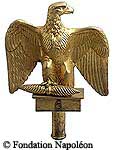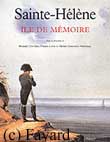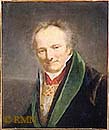| |
| |
THIS MONTH'S BOOK
Sainte-Hélène, île de mémoire
Exceptionally we bring you a book in French. But it's worth it. This very large book concentrates entirely on the island of St Helena, as it was yesterday, today, and as you have never seen it before, with more than 700 photographs, the majority of which have never before been published! Discovered more than five hundred years ago and today a forgotten British colony (15,000 habitants), still with no airport, more than 3,000 kilometres from the nearest land, St Helena has had a curious history. As a key commercial stopping point for trade with India (before the building of the Suez Canal), the island played an important role in European history. And in 1815, she became the jail of one of the most famous prisoners in history.

|
|
|
| |
 |
 |
NAPOLEONIC ARCHAEOLOGICAL DISCOVERIES
Under instruction from the archaeology section of the Nord-Pas-de-Calais region, a team of specialists from the French preventative archaeology institute, the Institut National de Recherches Archéologiques Préventives (INRAP), has performed a dig near Etaples on remains of the 19 huts in which soldiers from the Grande Armée were barracked as part of the invasion force soon to head for England. Amongst the many objects uncovered, uniform buttons were found bearing the number "6" set within a hunting horn - the distinctive button of the 6e Régiment d'Infanterie Légère, at that time under Marshal Ney. On the other hand, the presence of buttons marked "75", those of the 75e Régiment de Ligne, is yet to be explained because that regiment was not thought to have been present at the Etaples camp. This archaeology has made told us what these barracks were made (tiles for the roof, glass and lead or the glazed windows) and also how these camps (which contained 175,000 men) were organised, both on the inside and out.

|
|
|
| |
PREVENTATIVE ARCHAEOLOGY
The very recent scientific discipline has now become an integral part of archaeology as a whole. Indeed, preventative archaeology is regularly used where land development threatens heritage sites. Which is why developers now include in their timetables periods for the detection of finds, the dig itself, and the possible preservation any remains uncovered. In France today, preventative archaeology constitutes 90% of all archaeological work, which in terms of numbers adds up to more than 2,000 digs per year, 252,000 days worked. In 2004, this represented a cost nearly 120 million euros. The INRAP was founded on 1 February 2002 as a result of a law dated 17 January, 2001.
For further details on the INRAP, click here.

|
|
|
| |
THE CORRESPONDENCE OF VIVANT DENON ON NAPOLEONICA
Vivant Denon (1747-1825) was appointed director of the Louvre by Bonaparte on 10 November, 1801 and his administrative correspondence (in French) is a key source for art historians, including as it does details on commissions given to painter and sculptors, the great civic architectural projects of the period - Vendôme Column, the Carrousel Arc de Triomphe -, the organisation of the salons, etc. Denon spent thirteen years of his life immortalising the Napoleonic period, trying to create "the most beautiful museum in the universe". On napoleonica.org, the Fondation Napoléon's source website, there are more than 4000 of these letters, including more than 100 to Napoleon, whom he got to know on the expedition to Egypt.

|
|
|
| |
200 YEARS AGO
On 6 Brumaire, An XIV (28 October, 1805), a Caisse de l'extraordinaire (extraordinary funds bank) was founded for the collection and management of the funds taken from conquered countries and to be used for financing the war.
By any means possible...
As the Grande Armée progressed and won victory after victory (for example, on the 8th (30th), Masséna forced the Arch Duke Charles to retreat from Caldiero, on the 9th (31th), Murat won the victory at Lambach), a private individual who had lived for a long time in Russia sent a plan to the Interior Ministry suggesting various ways in which to fight against that country. One specific scheme was to weaken the "main force behind the Russian army, superstition" (!). His plan, he went on, was to "launch against the army a large balloon in the shape of St Nicholas, the idol of the Russian soldier, from which, by means of an explosion, a short proclamation would be shower down on the ranks. This proclamation was to bear a coloured image of the head of the saint and a legend saying that God forbade them to fight. The effect of this first balloon would merely be to frighten the soldiers. However, on the following day, against the army preparing to fight, we should launch a second balloon from which St Nicholas would mark his anger with several loud explosions. The people in the basket could then throw down glass phials filled with a thundering agent which would explode at a specific height with a great noise."
Bulletin of the Ministère de la police générale, 7 Brumaire, An XIV (29 October, 1805)
To see at a glance the events of the week 26 October to 1 November, 1805, click here.
Wishing you an excellent, Napoleonic, week.
Peter Hicks
Historian and Web editor
Interested in the work of the Fondation Napoléon? Why not participate, either generally or in a specific project, by making a donation.
© this Napoleon.org weekly bulletin is published by the Fondation Napoléon. Reproduction or all or part of this bulletin is forbidden, without prior agreement of the Fondation Napoléon.

|
|
|
|
|
|
|
|
|
|
THIS WEEK
LIBRARY AND FONDATION INFORMATION
The Fondation Napoléon and the library will be closed on Monday 31 October and Tuesday 1 November.
SNIPPETS
Sale of Napoleonica and Nelsonia at Christie's reaches record prices
JUST PUBLISHED
- NICASSIO, Susan Vandiver, Imperial City: Rome, Romans and Napoleon, 1796-1815
- MARKHAM, J. David, Napoleon and Doctor Verling on St Helena
WHAT'S ON
- Conference: Forum Marengo VII 2005 "The eagle and the bee", Alessandria, Italy
- Conference: 1805 - Napoleon, King of Italy, Conference and visits to Napoleonic sites, Rome, Italy
- Exhibition: Napoleon: An intimate portrait, Washington, USA
- Exhibition: Napoleone e il Piemonte. Capolavori ritrovati, Alba, Italy
- Exhibition: Napoleon: Art and Empire in the age of Trafalgar, Barnard Castle, UK
- Exhibition: The Empress Josephine: Art and Royal Identity, Amherst, MA, USA
- Exhibition: Nelson and Napoleon, National Maritime Museum, London, UK
THE MONTHLY TITLES
- This month's book: LENTZ, Thierry, CHEVALLIER Bernard (ed.), DANCOISNE-MARTINEAU Michel (ed.), Sainte-Hélène, île de mémoire
- This month's painting: The Empress Josephine in the park at Malmaison, by Prud'hon
- This month's article: Napoleon and the Corsican Dilemma - part 2, by Barbara Krajeswka
- In the Collectors Corner, Portrait of Napoleon (miniature set on a box) by ISABEY Jean-Baptiste
Got a problem with a link in the letter? Try the homepage http://www.napoleon.org
<<
|
|



